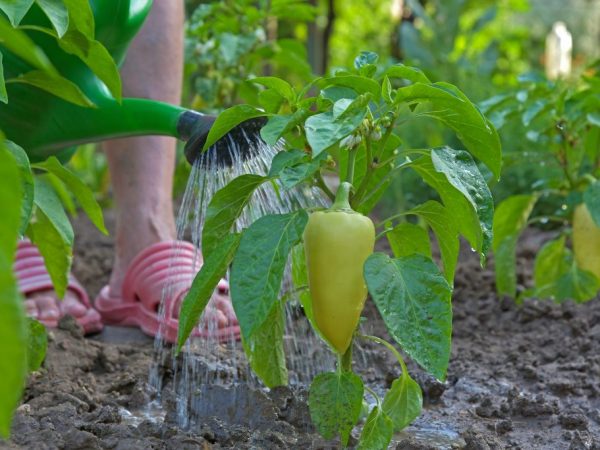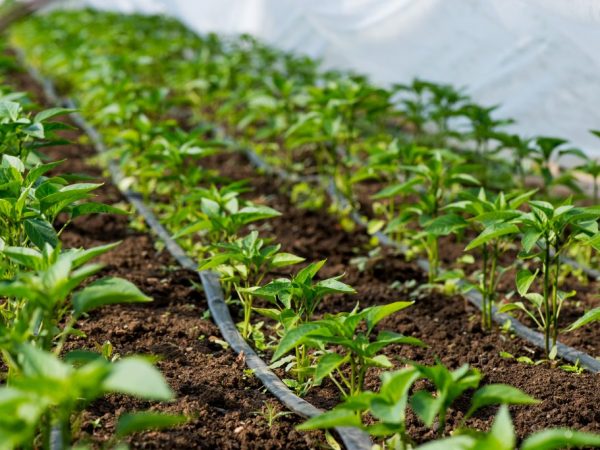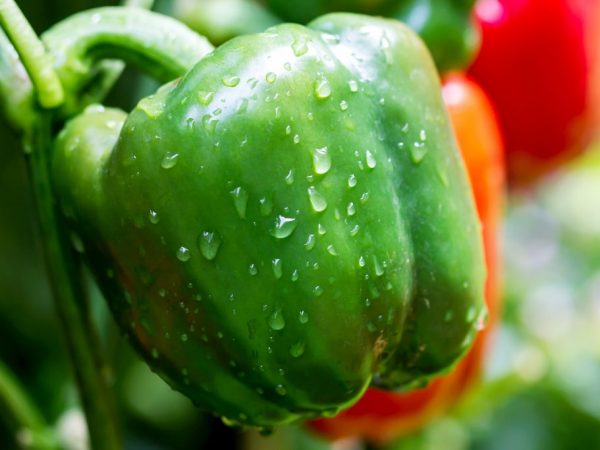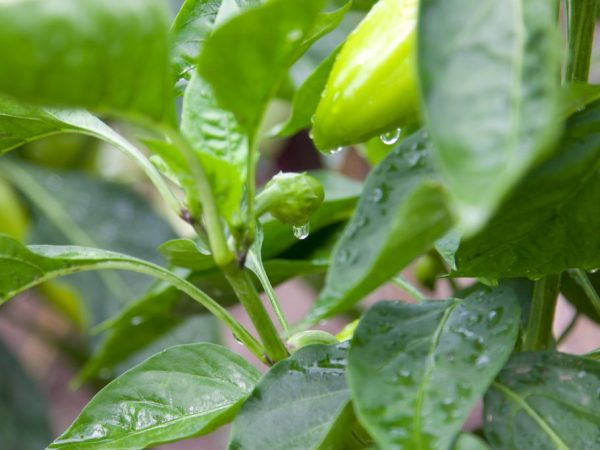Watering peppers in a polycarbonate greenhouse
It is not difficult to carry out high-quality watering of peppers in a polycarbonate greenhouse. It is important to observe the timing, frequency and choose the best irrigation option when water consumption is minimal and soil moisture is maximized. Let's take a closer look at how to water peppers in a greenhouse.

Watering peppers in a polycarbonate greenhouse
Irrigation frequency and rates
Polycarbonate greenhouses perfectly retain heat inside and maintain a certain level of humidity. To understand how many times you need to water the pepper, take into account the following criteria:
- air temperature;
- the length of a sunny day;
- humidity level;
- soil quality.
On average, young shoots are watered every 2 days before picking. 200-400 ml is applied under one plant. After transplanting into the ground, the frequency of watering is reduced to an average rate - once every 5-7 days. Adult seedlings are watered the same number of times throughout the growing season.
Another important rule is that only warm, settled water is used for irrigation. It is brought in at the root.
In addition, you need to regularly moisten the soil. The paths between the rows are watered 1-2 times every 3 days. Another way is to spray water on the sides of the polycarbonate greenhouse.
During the period of mass fruiting, watering stops for 1-2 weeks. This will help avoid the development of diseases and will increase the number of flowers on the plant.
Watering methods
Several methods are used to water peppers in a greenhouse. They have many differences, but the common feature is root irrigation.
Manual
Ideal for small greenhouses (up to 20 m2). It is the cheapest, often used, because does not require special costs for tools. It is used throughout the entire growth period of seedlings.
The process uses:
- watering cans;
- hoses;
- containers with water.
It is better to water young seedlings in a greenhouse with an area of up to 10 m2 with a watering can. It will allow you to properly distribute water, perfectly moisturize the soil. Only a small part of the water will fall on the leaves (which will not harm the bush). They buy watering cans with a volume of up to 12 liters, so that it is convenient and not hard to hold.
The hoses are best used for medium sized beds - 15 to 20 m2. Such watering of peppers in a polycarbonate greenhouse has its advantages - the speed of the procedure, a small amount of water. Along with the hose, special nozzles should be purchased, which allows you to regulate the water pressure. It is also necessary so as not to soak the soil and not damage small plantings.
Disadvantages of the manual method - the risk of uneven irrigation of plants when using a hose. It requires a lot of strength and energy.
Mechanical

Mechanical irrigation system will save you time
This is a common system formed of hoses of different sizes, diameters and lengths that are directed towards each bush. But this method cannot be called automated, because the amount and pressure of water is controlled by a person.
The main advantage is time saving.Unlike manual watering, the gardener does not need to walk and water each plant. During this time, he can irrigate all plantings in a polycarbonate greenhouse.
Another advantage is that the risk of water getting on the leaves of the plant is eliminated. If you purchase a meter, you can control the amount of water used in order to take measures in the future to reduce the cost of irrigation.
To use this method of irrigation, you will need an uninterrupted supply of water and electricity. To connect a fluid supply system, you need one of the structures:
- wells;
- wells;
- centralized rigid pipes.
The well is the best. It has sufficient depth and a higher quality of water than a well. She has a long period of operation.
Auto
It is a soil irrigation system consisting of sensors and pipes connected to each other. Pipes are needed to implement the irrigation process. Such a system requires human intervention only at the initial stage - during its installation, adjustment. It is necessary to make such settings - irrigation time and amount of water.
To create an unattended installation, you need:
- free access to electricity;
- power supply unit and remote control;
- organization of a system with an uninterrupted water supply;
- installation of pipes, sensors and nozzles.
It is advisable to use thick pipes that can withstand high water pressure. Water is supplied from high quality, deep wells, 1 or more wells, as with mechanical irrigation.
Automatic systems are appropriate in very large-scale greenhouses, where a person physically will not have time to water the pepper by hand. Another option is when growing especially demanding varieties or hybrids that require frequent soil and root system moisture.
Combined

A combined irrigation method is suitable for large greenhouses.
This method is often in great demand in modern conditions. Usually involves a combination of an automatic system and a manual irrigation method.
It is convenient and cost-effective to use in such cases:
- With frequent power outages. If the automation is off, the plants can be watered manually.
- When growing different varieties of peppers or other vegetables in the same garden. In this case, the automatic system will be problematic to rebuild for each plant, and installing pipes for each plant is not a cost-effective business. Therefore, the irrigation system can be positioned in one part of the greenhouse and manually irrigated in the other.
- With low water pressure. Often a phenomenon in the evening, when every gardener in the district wants to water the seedlings. Then the automation will not cope well with the work, and the gardener will be able to water the seedlings easily and quickly using a regular watering can.
The combined irrigation method should only be used in large greenhouses. Otherwise, it will be economically unprofitable.
Irrigation systems
Automatic irrigation consists of several irrigation systems: subsurface, sprinkler, drip. The subsurface method is suitable for growing moisture-loving peppers. It is difficult to regulate the water in it, due to which the distribution of moisture will be uneven.
After sprinkler irrigation, it is not necessary to carry out loosening, because there is no soil crust. But it greatly increases the moisture in the room, which is harmful for most varieties of peppers.
In a polycarbonate greenhouse, it is easiest to organize drip irrigation. The system consists of the following elements:
- barrels raised 1 m above the ground;
- crane;
- hose;
- pipes;
- water filter;
- corners;
- tees;
- tapes, etc.
Because this device is expensive, it is often used only in industrial enterprises. It is difficult to mount it yourself. But to carry out watering, you just need to press the "start" button. Also, a person is required to control the water in the barrel.
During the drip irrigation process, each plant will receive the required amount of water using an individual tube. The rate of application of the liquid will be determined by a special sensor for measuring soil moisture.
What is the danger of waterlogging of the soil

Peppers should only be watered with warm water.
Waterlogging is dangerous for the development of fungal infections. Gray rot, root rot, black leg, late blight may occur. They infect the plant first in the root system, then on the leaves, after which the fungus passes to the fruit. The result is spoiled peppercorns, forbidden for consumption.
Remember, fungal spores can be found not only in the soil, but also on the glass of a polycarbonate greenhouse. Therefore, it is important to regularly carry out wet cleaning and wipe the windows with soapy water.
If irrigation is carried out with cold water, the plant may freeze. This will stop the growth of the bushes and the formation of ovaries. Therefore, it is important to adhere to the water temperature, which is 20-25 ˚С.
The main mistakes when watering
Improper irrigation can provoke the development of rot or fungal infections. Often inexperienced gardeners make such mistakes:
| Mistake | Its description and solution |
| Use of substandard pipes | It is better not to save on pipes, because they must withstand a certain water pressure and be durable. Thin, soft pipes cannot be used. Better to buy a hard plastic that can last up to 5 years. |
| Untimely loosening of the soil | It is carried out only after watering. If you loosen the soil before irrigation, then there will be no positive effect and benefit. This should be done a day after watering to remove the soil crust. Another mistake is sloppy loosening. It is not necessary to bury the hoe very deeply into the ground so as not to touch the roots. |
| Excessive watering during flowering | There is a risk of falling flowers, which will reduce the yield several times. Therefore, during the flowering period, the amount of irrigation should be reduced. |
| Excess nitrogen | It is applied only when growing seeds. When the plant is formed, there is no need for this fertilizer. An excess of nitrogen prevents the plant from absorbing potassium, which can slow down the flowering process or stop it altogether. Therefore, it is better not to carry out nitrogen fertilizing during the growing season. |
| Very high room temperature | Pepper does not tolerate extreme heat and under conditions of elevated temperatures (from 35 ˚С), the inflorescences fall off en masse. It is important that the air temperature in the greenhouse is 28-30 ˚С. |
Always look at the condition of the soil. If it is dry and looks like sand, then urgent, abundant watering is needed. If the earth easily rolls into a ball and sticks to your hands, irrigation is stopped for 2 weeks. If it just rolls into a ball, but does not stick to the palms, the next moistening of the earth is carried out in a week.
Conclusion
To obtain a high-quality and healthy harvest on time, it is necessary to properly water the pepper in a polycarbonate greenhouse. It is important that the water temperature is 20 ˚С - 25 ˚С, the amount of water is 0.5-1 l.

